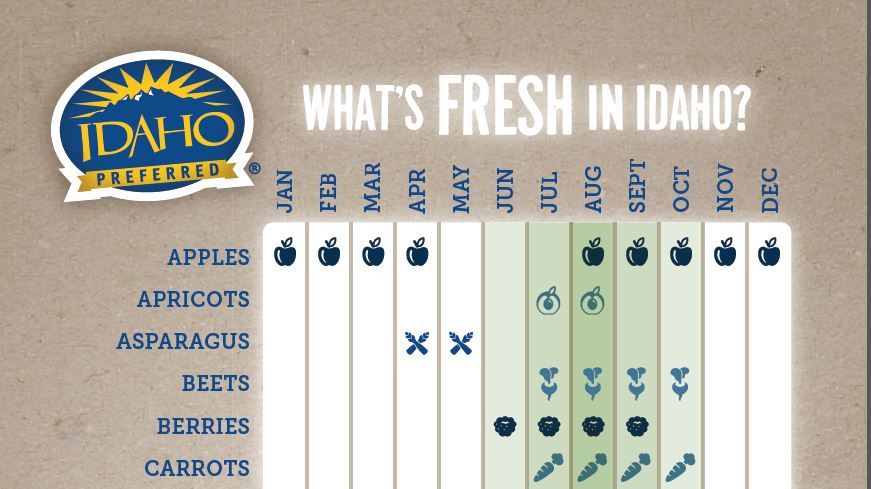Finding Healthy And Affordable Produce

 The Idaho Foodbank’s registered dietitian Alexa has some tips about how to make sure you’re getting healthy produce in an affordable way. It all starts with knowing what’s in season.
The Idaho Foodbank’s registered dietitian Alexa has some tips about how to make sure you’re getting healthy produce in an affordable way. It all starts with knowing what’s in season.
Fresh, Frozen, and Canned Produce
A busy lifestyle may not always allow us to have fresh vegetables on hand. But, there are benefits and drawbacks of fresh, frozen, and canned vegetables. For starters, no matter which way vegetables are stored they are always going to contain carbohydrates, protein, vitamins, minerals, fiber, and other plant chemicals, known as “phytochemicals,” all of which are good for us no matter what.
Fresh Fruits and Vegetables:
Fresh fruits & vegetables are portable choices. Whenever you leave the house, get into the habit of stashing a fresh snack in your purse or backpack; think: apple, orange, banana, or baby carrots. These snacks will keep you energized and avoid less-healthy snacks throughout the day.
- Look for Seasonal Choices: You will find good deals on produce when you buy it in season! Above is a chart with the Seasonal produce in Idaho! Check it out!
- Delicious uses:
- Always top sandwiches with extra vegetables.
- Serve a colorful fruit salad for dessert.
- Add pureed fruits and veggies to sauces, casseroles, smoothies, soups and more for a boost of flavor and nutrients.
Frozen Fruits & Vegetables
These are picked at the peak of ripeness and then flash frozen to preserve optimal nutrition. They last for several months in the freezer and can be a very economical choice.
- Watch for Sodium: Compare the sodium content on the Nutrition Facts label and choose the product with the lowest amount. Sauces and seasonings can contain excess salt and add calories.
- Watch for added sugar: Choose 100% frozen fruits without added sugars.
Delicious uses:
- When you boil pasta, throw in some frozen veggies at the end of the cooking time for added nutrients and variety.
- Whip up a smoothie of frozen fruit, nonfat or low-fat milk and yogurt.
- Mix frozen berries into baked goods and oatmeal.
Canned Fruits and Vegetables:
Canned fruits and vegetables are convenient to have in your pantry for times you can’t get to the store; they can even be kept at work (with a can opener) for an afternoon snack. Since they don’t expire quickly, you won’t waste money when buying canned veggies.
- Watch for sodium: Sodium is added to canned foods as a preservative. Look for low-sodium, reduced-sodium or no-salt-added labeled foods. Compare the sodium content on the Nutrition Facts label and choose the product with the lowest amount. Always drain and rinse canned veggies to reduce sodium even more.
- Watch for added sugar: Look for fruit that’s canned in water, its own juice, or light syrup (drain and rinse).
Delicious uses:
- Add drained cans of corn, tomatoes and pinto beans or any other vegetable to low-sodium chicken broth for a super-fast and filling vegetable soup.
- Use a blender, food processor or a fork to smash drained and rinsed garbanzo beans, northern beans, or any beans into a bean dip for baby carrots; add a little lemon juice and garlic powder.
- Serve canned fruit as a dessert topped with low-fat, no sugar-added yogurt; or top whole grain cereal with canned fruit.
Whether fresh, frozen, or canned fits into your lifestyle, select any type that you’ll enjoy eating. The number of servings needed in a day varies depending on your age and other factors, however, adults generally need about 2.5 to 3 cups of vegetables and 1.5 to 2 cups of fruit each day.


